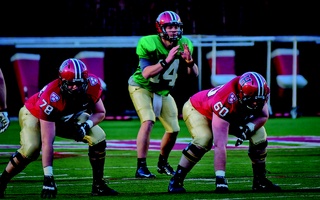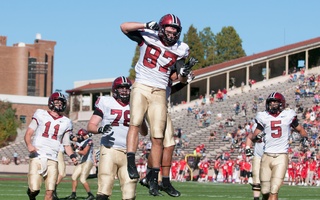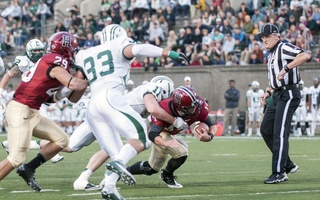That reality occurred to Hamblin, as it did to Zorn. When Zorn was a freshman, Harvard’s QB depth chart was clogged up with bigger names such as Collier Winters, Colton Chapple, and Michael Pruneau. The coaching staff originally proposed using Zorn’s athletic ability at cornerback, but a torn labrum requiring surgery put him on the sideline for his entire freshman season.
At the end of the year while in a meeting with Murphy, Zorn floated the idea that he learn the offense to gain experience at the wide receiver position.
“[Murphy] emailed me the very next day, saying, ‘I’ve been thinking about your interest in playing wide receiver, and I think it would be great if you went ahead and made the switch,’ Zorn said. “That’s how I switched to wide receiver.”
A LEARNING PROCESS
Zorn and Hamblin may be thriving today, but it wasn’t always that way. It took lots of practice and a significant adjustment period to acclimate to a new role.
Hamblin began his sophomore fall as the low man on the totem pole. Possessing good hands, the receiving aspect came relatively quickly. But playing on the line brought along new challenges, from run blocking to route running.
For Hamblin, the presence of then-senior tight end Kyle Juszczyk, who now plays for the Baltimore Ravens, was crucial. Along with senior tight end Cam Brate, Juszczyk took Hamblin under his wing and taught him the ins and outs of the position.
“The biggest thing for me moving to tight end was learning how to block,” Hamblin said. “What helped me was watching film and watching the line so much that I could pick up the footwork relatively quickly. I just had to get in the weight room and get stronger.”
Zorn spent the summer after his freshman year training with Pruneau, also a rising sophomore from the Lone Star State then. He studied the offense over the offseason, started becoming familiar with the wide receiver position, and played much of his sophomore year on the JV squad.
Zorn made his first collegiate start his junior year against Holy Cross. He came out with a bang, amassing 99 receiving yards and reeling in a touchdown. With only one year of wide receiver experience under his belt, Zorn registered a catch in every 2012 game.
“He missed his whole freshman year because of surgery, so it took a little longer to sink in that maybe quarterback wasn’t going to be his position,” Murphy said. “But the way it’s turned out, I think everybody’s really happy.”
Zorn’s quarterback background helped him pick up the nuances of being a wideout more quickly than he would have otherwise. Even though he had never played the position, he knew what receivers needed to do to contribute to an aerial attack and mesh with their quarterbacks.
“Quarterbacks are always trying to coach their wide receivers,” Zorn said. “So they have a good idea what it takes to be a wide receiver, even though they haven’t gone out there and actually ran routes in practices.”
According to Hamblin, being a quarterback gave him the soft hands he needed to aid the transition to tight end. But his experience directing an offense was just as critical on the mental side of things, having learned firsthand how helpful it is when receivers are detail-oriented.
“One of the things about Tyler that’s allowed him to really blossom is that he approaches the game like a quarterback,” Murphy said. “He’s one of those guys in meetings who is probably more well-versed in our offense in general and the nuances of his position than anybody in our meeting room.”
Read more in Sports
Players Remember '29-29,' 45 Years LaterRecommended Articles
-
 Crimson, White Battle in Spring Game
Crimson, White Battle in Spring Game -
 Football Looks to Rebound Against Dartmouth
Football Looks to Rebound Against Dartmouth -
 Football Beats Dartmouth in Final Minute, 24-21
Football Beats Dartmouth in Final Minute, 24-21 -
 What Your Text Punctuation Really Means
What Your Text Punctuation Really Means -
Football Season RecapIn a season filled with triple-overtime games, nail-biting victories and defeats, and last-second field goals, what was perhaps the most crucial game for the Harvard football team was not even played by the Crimson
-
 Upon Further Review: How Holy Cross Was Beat
Upon Further Review: How Holy Cross Was Beat













